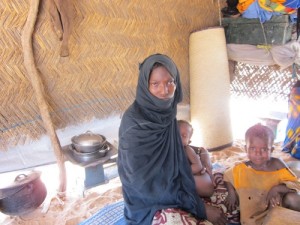In Northern Africa, Climate Change Could Make A Current Refugee Crisis Even Worse
 Niger is the poorest of the nine countries that comprise the Sahel, a belt that stretches across northern Africa from the Atlantic Ocean to the Red Sea bounded by the Sahara desert to the north.
Niger is the poorest of the nine countries that comprise the Sahel, a belt that stretches across northern Africa from the Atlantic Ocean to the Red Sea bounded by the Sahara desert to the north.Food insecurity and malnutrition are chronic in Niger. But things this year are worse. For the third time in just seven years, Abala and the surrounding areas have been especially hard hit by poor rains and low agriculture yields that have left a mind-boggling 16 million people across the Sahel without sufficient food.
But it is neither the recurrent drought nor the lack of food that has brought me to Abala today. Less than a mile from here, 9,000 Malian refugees are camped. They started coming in January when Tuareg separatist groups, having returned well-armed from Libya, mounted a rebellion in northern Mali. The Mali refugees who fled to Abala are mainly pastoralists, and many have brought their animals with them. Two thousand head of livestock are now registered at the camp.
I ask the mayor how he feels about the refugees whose population will soon outnumber that of the local inhabitants. “They are our brothers and sisters. We welcome them with open arms. They need our help and we will share with them what we have.” Given the fragile landscape and scarce resources, I am floored by the conviction and magnanimity of his response.
Getting sufficient food and water to the people of Abala – and the livestock on which many depend for their survival – are significant challenges that existed long before the arrival of the refugees. But now the influx of thousands of new arrivals has put significant additional burden on these host areas. Because there is no potable water in Abala, water has to be trucked in daily to meet the burgeoning demands of the refugees. While aid agencies are in the process of drilling wells in order to provide a local source of water to both refugees and the local community, so far they’ve been unsuccessful, turning up nothing but salty water.
The cooperation between host communities and refugees, and the efforts by humanitarian agencies to juggle the needs of both, is encouraging. Yet while minimum needs are being met, I can’t help but wonder how long the government and the international community can continue to depend on the good will of the people of Abala.
Three weeks from now, the rainy season will start, and getting food and water to this remote area will become a serious challenge (there are no paved roads to Abala). And the impact of the refugees on this fragile landscape is already being felt in terms of deforestation and loss of available pasture. Already people must spend an average three hours a day in search of firewood. With more refugees arriving daily, and as these resources grow even scarcer as the region enters the leanest months of the year, there is serious risk that tensions between and among local populations and refugees could increase.
Humanitarian funding to support the Malian refugees who have fled to Niger and other neighboring countries has been limited and is quickly running out. But equally disturbing is the lack of international attention and response to the broader human insecurity in the region, and the unwillingness of donors to seriously confront the more systemic and growing problems that plague the Sahel. Chronic poverty and malnutrition are being compounded by more frequent and extreme droughts and crops failures.
Back in Niger’s capitol, Niamey, I meet with the head of an international NGO that has been responding to both the food crisis and now the Mali refugees. We discuss the recurrence of climate-related disasters in the Sahel, and the fact that these crises are falling closer and closer to each other — leaving vulnerable populations with less and less time to recover before the next shock hits. “No one here is thinking beyond six months, or a year. No one wants to put time and money into the long-term problems facing the region.”
While donors claim to be increasing the “resiliency” of vulnerable populations to withstand and rebound from more frequent climate extremes, there is little evidence that resilience programs are being implemented at the scale and scope necessary to address the overwhelming counter-pressures of climate change and population growth. Short-term humanitarian funding is necessary, of course, to prevent pushing vulnerable populations over the brink. But emergency response funds are insufficient in timescales and amounts to effectively address the far deeper threats to the Sahel.
It’s time for the international community to stop ignoring what’s happening here.
You can return to the main Market News page, or press the Back button on your browser.

